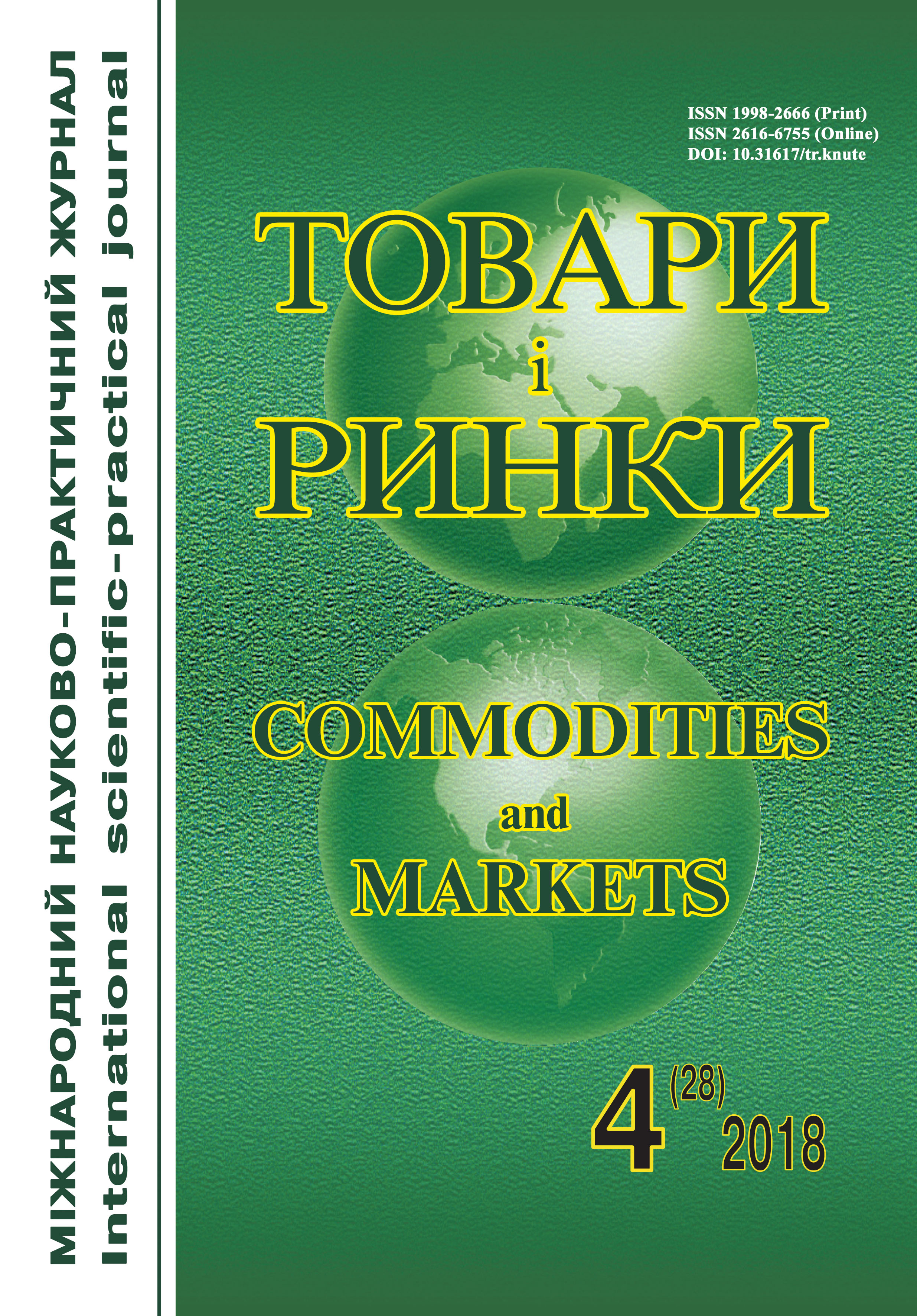Optical properties of new types of paper packaging
Keywords:
packaging, kaolin, cellulose fibers, paper opacity, whiteness of paperAbstract
Background. Environmental paper materials are gaining worldwide popularity in recent years. At the same time, the most problematic issue is the development of paper with an optimal ratio of optical indicators (opacity, whiteness) and strength at minimum mass and thickness.
Different methods, approaches and technological solutions are used in each particular case to ensure the required level of a particular indicator of the quality of the packaging paper. Therefore, the problem of simultaneous increase of opacity and whiteness of paper with the preservation of its strength is not resolved.
The aim of the work is to improve the optical properties of the packaging paper with preserving its strength.
Material and methods. Materials of scientific works were used. The objects of the study were packaging paper, sulfate whitened pulp from coniferous and hardwood, as well as kaolin filler. The methods of complex analysis and synthesis were applied. The research of quality indices of packaging paper was carried out according to standardized methods [12–14] adopted in pulp and paper industry.
Results. Amethod for producing food packaging paper was invented according to the results of the research. It is a microporous fiber material, made of a paper mass comprising pulverized fibers of bleached cellulose from coniferous and deciduous wood, mineral filler, binder and gumming agents, and characterized in that the paper mass contains a mixture of fibers of cellulose from coniferous wood, grinding to a degree 42–44°ShR, and cellulose from deciduous wood, grinding to a degree 24–26°ShR, and getting of a fraction cellulose fibers from coniferous and deciduous wood mixed before molding (outpouring) of paper with the ratio of the masses: cellulose from coniferous wood – 85–90 %, cellulose from deciduous wood – 10–15 %.
Kaolin with a mass fraction of 2–3 microns 92–94 % and whiteness (reflection coefficient) of 87 % is used as mineral filler. The mass fraction of the filler in the paper is 8–9 % of absolutely dry fiber.
Conclusion. A method of producing food packaging paper is proposed according to the results of the research. This method is an original composition of a microporous fibrous material made from a paper mass comprising a mixture of fibers from pulp of coniferous and deciduous wood, ground to a different degree of fraction, a mineral filler of kaolin and sizing agents. This method allows providing a high degree of paper opacity at low content of the filler with the preservation of a sufficiently high whiteness and mechanical strength compared to counterparts.
References
Mostyka, K., Koptjuh, L., Osyka, V. (2015). Analiz vymog do paperu dlja upakuvannja harchovyh produktiv [An analysis of the requirements for paper packaging for food products]. Tehnologichnyj audyt ta rezervy vyrobnyctva – Technological audit and production reserves, 6/4, 29-35 [in Ukrainian].
Rodrigues dos Santos, I., Ventorim, G., Caraschi, J. Impact of kaolin filler on physical and mechanical paper properties formed by ECF pulp. Cerne. 2014. N 20 (2). P. 231-238 [in English].
Zaharri, N., Othman, N., Mohd Ishak Z. Effect of Zeolite Modification via Cationic Exchange Method on Mechanical, Thermal, and Morphological Properties of Ethylene Vinyl Acetate/Zeolite Composites. Advances in Materials Science and Engineering. 2013. Retrieved from https://www.hindawi.com/journals/amse/2013/394656 [in English].
Popov, N. (2001). Kamenogorka + [Kamenogorka +]. Mir bumagi – The world of paper, 3, 38-40.
Rastogi, V., Samyn, P. Bio-Based Coatings for Paper Applications. Coatings. 2015. N 5 (4). P. 887-930 [in English].
Jovanović, S., Krgović, M., Ošap, D. Application of natural and synthetic polymers in a production of paper. Hemijska Industrija. 2007. N 61 (4). Р. 171-185 [in English].
Peşman, E., Tufan, M. The Effects of CaCO3 Coated Wood Free Paper Usage as Filler on Water Absorption, Mechanical and Thermal Properties of Cellulose-High Density Polyethylene Composites. Medžiagotyra. 2016. N 22 (4). Р. 530-535 [in English].
Martins Lopes, C., Ramiro Fernandes, J., Martins-Lopes, P. Application of Nanotechnology in the Agro-Food Sector. Food Technology and Biotechnology. 2013. N 51 (2). P. 183-197 [in English].
Coccia, V., Cotana, F., Cavalaglio, G. Cellulose Nanocrystals Obtained from Cynara Cardunculus and Their Application in the Paper Industry. Sustainability. 2014. № 6 (8). Р. 5252-5264 [in English].
Kermanian, Н., Rafiei, S., Rasooly, E. The effect of type and mixture of resin on the properties of impregnated paper. Iranian Journal of Wood and Paper Industries. 2017. N 8 (1). Р. 25-38 [in English].
Mostyka, K., Osyka, V., & Koptjuh, L. (2015). Doslidzhennja vlastyvostej zhyronepronyknogo pakuval'nogo paperu [Investigation of properties of greaseproof packaging paper]. Mizhnar. nauk.-prakt. zhurn. "Tovary i rynky" – International scientific and practical magazine "Goods and Markets", 2, 98-105 [in Ukrainian].
Napivfabrykaty voloknysti, papir ta karton. Metod vyznachennja masy produkcii' ploshheju 1 m2 [Fibrous semi-finished products, paper and cardboard. Method of determining the mass of the product area of 1 m2]. (1996). DSTU 2297–93. (GOST 13199–94). Kyi'v : Derzhspozhyvstandart Ukrai'ny [in Ukrainian].
Papir ta karton. Vyznachennja micnosti pid chas roztjaguvannja. Ch. 1. Metod navantazhuvannja z postijnoju shvydkistju [Paper and cardboard. Determination of strength during stretching. Part 1. Method of loading at constant speed]. (1997). DSTU 2334–94 (GOST ISO 1924/1–96). Kyi'v : Derzhspozhyvstandart Ukrai'ny [in Ukrainian].
Papir i karton. Vyznachennja bilosti za CIE, D65/10 o (zovnishnje denne osvitlennja) [Paper and cardboard. Determination of whiteness for CІE, D65 / 10 о (external
daylight)]. (2006). DSTU ISO 11475:2005. Kyi'v : Derzhspozhyvstandart Ukrai'ny [in Ukrainian].
Bumaga obertochnaja. Tehnicheskie uslovija [Paper wrapping. Technical specifications]. (1998). GOST 8273–75. M. : IPK Izd-vo standartov [in Russian].



